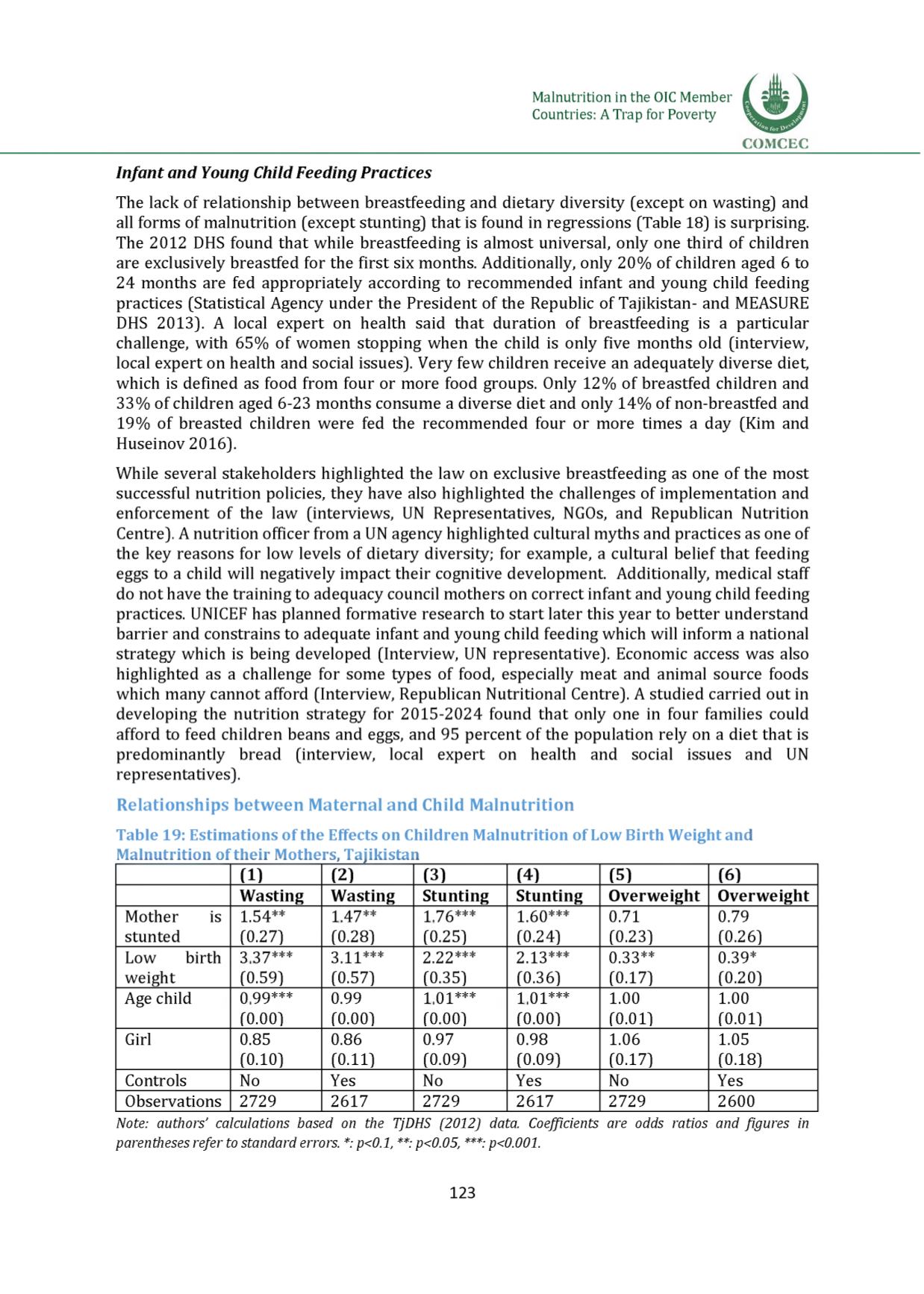

Malnutrition in the OIC Member
Countries: A Trap for Poverty
COMCEC
Infant and Young Child Feeding Practices
The lack of relationship between breastfeeding and dietary diversity (except on wasting) and
all forms of malnutrition (except stunting) that is found in regressions
(Table 18)is surprising.
The 2012 DHS found that while breastfeeding is almost universal, only one third of children
are exclusively breastfed for the first six months. Additionally, only 20% of children aged
6
to
24 months are fed appropriately according to recommended infant and young child feeding
practices (Statistical Agency under the President of the Republic of Tajikistan- and MEASURE
DHS 2013). A local expert on health said that duration of breastfeeding is a particular
challenge, with 65% of women stopping when the child is only five months old (interview,
local expert on health and social issues). Very few children receive an adequately diverse diet,
which is defined as food from four or more food groups. Only 12% of breastfed children and
33% of children aged 6-23 months consume a diverse diet and only 14% of non-breastfed and
19% of breasted children were fed the recommended four or more times a day (Kim and
Huseinov 2016).
While several stakeholders highlighted the law on exclusive breastfeeding as one of the most
successful nutrition policies, they have also highlighted the challenges of implementation and
enforcement of the law (interviews, UN Representatives, NGOs, and Republican Nutrition
Centre). Anutrition officer from a UNagency highlighted cultural myths and practices as one of
the key reasons for low levels of dietary diversity; for example, a cultural belief that feeding
eggs to a child will negatively impact their cognitive development. Additionally, medical staff
do not have the training to adequacy council mothers on correct infant and young child feeding
practices. UNICEF has planned formative research to start later this year to better understand
barrier and constrains to adequate infant and young child feeding which will inform a national
strategy which is being developed (Interview, UN representative). Economic access was also
highlighted as a challenge for some types of food, especially meat and animal source foods
which many cannot afford (Interview, Republican Nutritional Centre). A studied carried out in
developing the nutrition strategy for 2015-2024 found that only one in four families could
afford to feed children beans and eggs, and 95 percent of the population rely on a diet that is
predominantly bread (interview, local expert on health and social issues and UN
representatives).
Relationships between Maternal and Child Malnutrition
Table 19: Estimations of the Effects on Children Malnutrition of LowBirth Weight and
Malnutrition of their Mothers, Tajikistan
(
1
)
(
2
)
(3)
(4)
(5)
(
6
)
Wasting Wasting Stunting Stunting Overweight Overweight
Mother
is 1.54**
1
4 7
**
1 76***
1.60***
0.71
0.79
stunted
(0.27)
(0.28)
(0.25)
(0.24)
(0.23)
(0.26)
Low
birth 3
3 7
***
3
1 1
***
2
.
2 2
***
2.13***
0.33**
0.39*
weight
(0.59)
(0.57)
(0.35)
(0.36)
(0.17)
(
0
.
2 0
)
Age child
0
9 9
***
0.99
1
0 1
***
1
0 1
***
1 . 00
1 . 00
(
0
.
0 0
)
(
0
.
0 0
)
(
0
.
0 0
)
(
0
.
0 0
)
(
0
.
0 1
)
(
0
.
0 1
)
Girl
0.85
0 . 86
0.97
0.98
1.06
1.05
(
0
.
1 0
)
(
0
.
1 1
)
(0.09)
(0.09)
(0.17)
(0.18)
Controls
No
Yes
No
Yes
No
Yes
Observations 2729
2617
2729
2617
2729
2600
Note: authors' calculations based on the TjDHS (2012) data. Coefficients are odds ratios and figures in
parentheses refer to standard errors. *: p<0.1, **: p<0.05, ***: p<0.001.
123
















